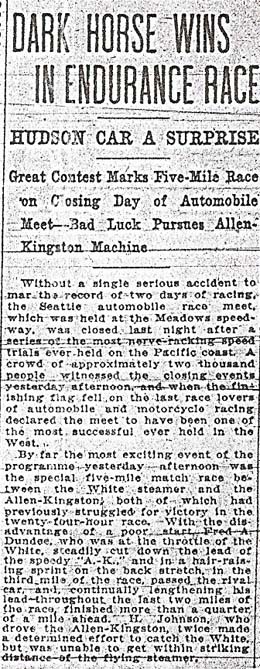At 9 p.m. on September 10, 1909, the first 24-hour automobile race held in the Northwest begins at The Meadows racetrack near Georgetown. The three-car race features hours of monotonous lap-after-lap driving, a breathtaking near-collision at high speed, and a surprise finish by an unlikely winner, whose average speed for the race is a whopping 29 miles per hour.
Going Fast
The Meadows was a one-mile dirt track, located south of Georgetown along the Duwamish River. Built in 1902, it soon became a favorite spot in the Northwest for horse racing, and also saw the Northwest's first automobile race in August 1905. Then, in September 1909, a series of auto and motorcycle races were held in Seattle: Timed hill-climbing sprints were held on Queen Anne Hill, and a number of races of various lengths, ranging from one to 100 miles long, were held at The Meadows. But the big race was the 24-hour endurance race.
Rain overnight on September 9-10 muddied the track and made it so slippery that some of the shorter races scheduled for the afternoon of the 10th were postponed for a day, but the 24-hour race began at 9 p.m. on Friday, September 10, with a de rigueur opening by a brass band playing military music. Spectators cheered as the three race cars began circling the brightly-lighted track, led by a fourth pace car, dismissively described by the Seattle Post-Intelligencer as a "doughty little twenty-horse power Ford." The Ford paced the other three cars for an hour at about 30 m.p.h. so the cars could work the track, soft from rain and oil, into firmer shape better suited for a 24-hour endurance race. At 10 p.m. the Ford pulled out of the race and the other three racers settled in for the long haul.
A Mud Track and a Potato Patch
The three race cars were an Allen-Kingston, a Hudson, and a White Steamer. They cruised along in a rather monotonous circle of laps, interrupted briefly about 11 p.m. when the White accidentally drove off the track and into a potato patch. (Within 10 minutes it was back in the race.) The race continued through the wee hours of the morning, with the spectators gradually drifting away until, by 4 a.m., only a handful of spectators and officials remained, doubtlessly getting bored and tired.
Maybe a little too tired. Just after 4 a.m., the Hudson pulled in for a pit stop to change tires and take on gas and oil. Someone wasn't paying attention, and the Hudson was allowed back out onto the track just as the other two racers were coming onto the stretch behind it. The Hudson's driver, apparently unaware of the two racers rapidly closing behind him, failed to stay on the outside of the track as the rules required and instead cut in front of the other two drivers to the inside of the track. The three cars, traveling at about 60 m.p.h., all caught up to each other as they reached the first turn, described by the Post-Intelligencer as being soft and muddy, and the worst spot of any part of the track.
Winning, Fishtailing, Losing
The Hudson's driver finally realized his mistake and swerved to the outside of the track, while the Allen-Kingston hugged the inside. The White found itself sandwiched between them with only inches to spare (the next day the Seattle Post-Intelligencer said "at no time were there more than three inches of leeway between the White and the two other cars"). Worse, the White began to fishtail in the mud as it made the turn, and only the rock steady hand of driver Fred Dundee saved the day.
The race continued without incident through Saturday morning, then was stopped at 1 p.m. so that other, shorter races (by both automobile and motorcycle) could be held on the track. The 24-hour race resumed at 6 p.m. By this time the Allen-Kingston had established a commanding lead of nearly 200 miles over its nearest rival, the Hudson, and could have almost coasted to victory from there. But minutes after the cars got back on the track, a broken differential knocked the Allen-Kingston out of the race. Its crew worked with increasing desperation to try to fix the car in time, but gave up in despair when it became apparent that the Hudson would win.
A respectable crowd was on hand at 2 a.m. on Sunday, September 12, when the race ended. The Hudson -- considered the dark horse by most -- won with a total of 706 miles, or an average speed of 29.42 miles per hour for the entire race. Despite its breakdown, the Allen-Kingston still traveled more total miles than the White (and only 26 miles less than the Hudson), but was disqualified from second place because it did not finish the race. That honor went to the White, which also had the dubious honor of catching on fire twice during the marathon and still managing to finish. The prizes were generous by 1909 standards: $500 for first place (nearly $10,000 in 2008 dollars), followed by $300 for second, and $200 for third.

